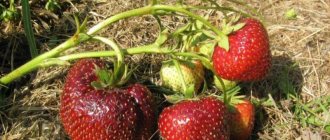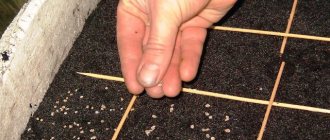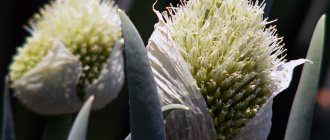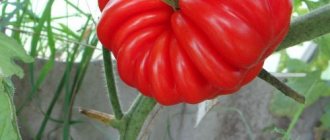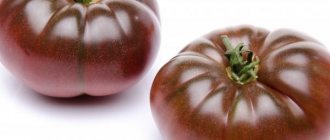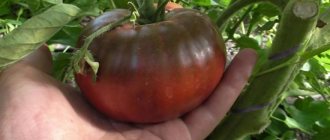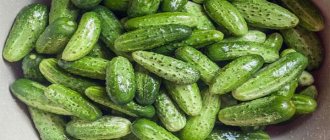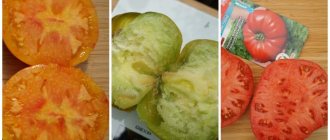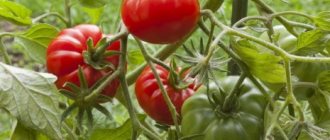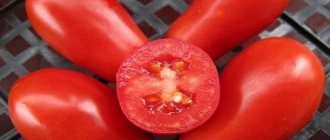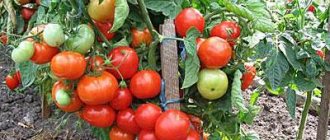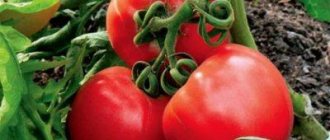Basic ideas about the variety
The correct location on the site, features of growing and caring for plants, this and other useful information is contained in the characteristics and description of the variety.
- Bush: indeterminate.
- Height: 1.7–1.8 m
- Number of tomatoes per brush: 12–15 pcs.
- Ripens within: 100–110 days.
- Shape: pepper-shaped or banana-shaped.
- Size: 20 cm.
- Color: red.
- Density: high.
- Transportability: excellent.
- Shelf life: 1 month.
Bananza is a variety of tomato plant
Variety characteristics:
Properties of the Bananza variety:
Recommended region on the map:
Information on the admission of Tomato Bananza from the Register of the State Variety Commission of the Russian Federation
Application for admission No. 62119, registered 2013-11-15. The Tomato Bananza variety was included in the register of those approved in 2015. Approved for use in regions: All regions.
The originator of the Tomato Bananza variety is:
Other varieties of tomato plant
Search for variety by name
Variety selection
Question to the portal experts
If you haven't found the answer to a question, don't hesitate to ask an expert.
Register or Login so you don't have to enter your Name and Email every time
Thanks for the comment! It will be published after checking by a moderator!
No comments yet, be the first!
A portal for those who love their dacha
Your question has been sent for moderation. Don't worry, we quickly check your questions and your question will be answered within 1 day.
We have noticed that you are already registered on our website. We recommend that you log in to view the question you created. If you don't remember your password, you can recover it.
You were not registered until today, so we have registered you. Your password has been sent to your specified mailbox.
Help our site develop!
Please read this message, it will not take up much of your time!
We so need your comments and questions to understand in which direction we should develop.
Don't forget to leave a comment if you found what you were looking for. And if you haven’t found it, use the “Ask an Expert” form in the site header. We will answer this question, and other visitors will be able to find the information that you could not find.
Sincerely, team of the portal Dacha-Dacha.ru
Your question has been sent for moderation. Don't worry, we quickly check your questions and your question will be answered within 1 day.
We have noticed that you are already registered on our website. We recommend that you log in to view the question you created. If you don't remember your password, you can recover it.
You were not registered until today, so we have registered you. Your password has been sent to your specified mailbox.
Planting and caring for the plant
Tomato seeds are sown 2 months before transferring to the greenhouse. At the stage of the 1st true leaf, they are picked into separate containers. It is enough to feed once with growth-stimulating fertilizers.
In order for the seedlings not to stretch out, but to form strong stems, it is necessary to observe the heat and light conditions. Lighting 12 hours in a relatively cool room.
Bonanza tomatoes are formed into one stem; they constantly produce side shoots. Growing stepchildren will lead to the fact that the tomato will develop a lot of green mass, and there will be few fruits.
Water with warm water, preferably in the evening. Weeding and loosening are carried out as preventive measures to prevent certain diseases.
Bonanza tomato seedlings
Tomato seeds are planted for seedlings in pots at the end of February - early March, and only on the 55th - 65th day can they be transferred to open ground.
While the seedlings are forming a root system, growth is very slow. During this period, you should not get carried away with watering and fertilizing; it can only be done once.
Healthy tomato harvest
As soon as the first leaf appears, the plant will begin to grow rapidly. In order for the seedlings to be strong and not pampered, they must be in a cool place with a day length of at least 12 hours.
In this case, the tomato will grow green mass rather than grow a stem. At this time, you need to increase watering and do not forget to feed the plants.
When the plant has not one, but as many as 5 leaves, it is necessary to monitor its formation.
So, for example, make sure that it does not overgrow, has comfortable conditions, sufficient lighting, watering with organic matter and always a moderate temperature in the place of cultivation.
I have a large garden and vegetable garden, several greenhouses. I love modern methods of cultivating plants and mulching the soil, and I share my experience.
Preparation for planting seedlings with Bonanza tomatoes, according to reviews, should begin in the autumn. During this period, you need to prepare containers where tomatoes will be cultivated. It is important to prepare the soil. You can simply take soil from the garden or forest. The second option is preferable, since forest soil contains fewer pests and other infections characteristic of garden crops.
We recommend adding humus (about half the mass of the soil) and peat deoxidized with ash (a quarter of the volume of forest or garden soil) to the substrate. If the resulting soil mixture seems too dense, you can add old sawdust to it.
1.5-2 weeks before planting the seeds, the soil mixture needs to be calcined in the oven. This will protect future Bonanza tomato seedlings from diseases. For seedlings, blackleg is especially dangerous - stem and root rot, for which there is no treatment.
We recommend using a wooden or plastic box as a container for seedlings, with drainage holes prepared in advance in the bottom.
To speed up the growth of tomatoes, you can germinate the seeds before planting. To do this, the planting material must be wrapped in damp gauze or cloth moistened with warm water. The described package is placed in a warm place.
Several times a day you need to check the planting material and spray it with warm water from a spray bottle. After a few days, white sprouts will appear on the seeds. This means it's time to start planting.
The soil needs to be laid out in a prepared box, grooves 1.5 cm deep should be made there at a distance of 2-3 cm from one another. The seeds need to be placed in these grooves. It is advisable that they be at a distance of 2-3 cm. After finishing the work, the laid seeds should be sprinkled with light soil and watered with warm water through a diffuser.
It is advisable to add manganese, dry boric acid or another fungicide to the water. This can only be avoided if the seeds were soaked in a fungicidal solution before planting.
After watering, the container should be covered with film and placed in a warm (21-25 degrees), shaded place for germination. Seedlings need to be checked and ventilated every day. Moisten the beds as the soil dries.
As soon as the sprouts appear, the cover must be removed and the plants must be provided with good lighting. It is important not to miss the moment, otherwise the tomatoes will be deformed, thin and pale.
When 2-3 true leaves appear, the seedlings can be pruned. This will improve root development in the future. If the number of plants is small, we recommend using glasses or peat tablets. This way, future transplantation to the site will be less traumatic.
We recommend watering them with a weak solution of fungicide 2-3 times during the growth of seedlings. This is a good fungus prevention. If dark spots on the stem are noticed on any of the tomatoes, such plants need to be removed, and those located nearby should be treated with a working solution of the fungicide.
If this happens, it is important to reconsider the conditions of care. Perhaps the crop is over-watered or the room is too cold.
Harvest volume and application
The yield of the variety is up to 3.5 kg per bush. This is subject to proper care and fulfillment of basic agrotechnical requirements. It bears fruit for a very long time. According to summer residents who left reviews, if the growth point is not removed, the bush will form about 40 brushes.
Tomatoes are used very widely. Because of their shape, housewives use them to prepare assorted cucumbers. They look very impressive. In addition, they decorate the table for the holiday and prepare fresh salads. Perfect for canning whole fruits.
Positive and negative aspects of the species
When choosing varieties for a plot, a summer resident pays attention to many details. Negative and positive characteristics help in choosing.
- The versatility of using tomatoes.
- Disease resistance.
- The yield is excellent.
- The fruits do not crack.
- It bears fruit for a very long time, so you don’t have to renew the plants in the greenhouse for a long time.
- Compact, can be planted more often than bushes of other varieties.
- Be sure to shape the plant; this is most difficult for beginners to cope with.
- Not suitable for outdoor cultivation
Features of Bonanza tomatoes according to gardeners' reviews
Those who have planted the Bonanza variety know that it has both advantages and disadvantages.
- has excellent immunity, like many hybrids;
- high yield, sometimes reaching 40-50 bunches;
- has a long life span, which makes it possible not to renew plantings in greenhouses for a long time;
- constantly forms generative buds, and this contributes to the laying of more and more new fruits;
- The bushes are compact, grow upward, and therefore take up little space in the greenhouse in width. Those. you can rationally use the area;
Growing tomatoes in a greenhouse (photo)
- due to unlimited growth, it has a fairly long development of the vegetative part;
- beginners experience some difficulties when growing this variety, since the rich foliage, long stems and heavy fruits require the installation of supports and timely pruning and stepsons;
- later fruit ripening, only on 30–40 days;
- practically unsuitable for open ground, especially where the summer period is short;
- seeds cannot be collected for next year.
Also, many people know firsthand about its taste and excellent characteristics, as well as high productivity for a long time.
Origin of Tomato Banana Legs
The Banana Legs tomato was bred in 1988 in the USA by breeder T. Wagner. It quickly spread throughout the world, and not only in countries with warm climates. It must be admitted that in our country the Banana Legs variety is mostly known in the south, somewhat less so in the middle zone. There is no entry about the variety in the State Register of Breeding Achievements of the Russian Federation; Russian gardeners receive information about it from each other and from periodicals, including the Internet.
The variety has become quite popular due to its original shape and excellent taste of the fruit, good yield, and the ability to grow both in open and protected ground.
First of all, the Banana Legs variety attracts with its bright color and unusual shape of the fruit.
Features of care
Experienced summer residents who have been growing Tamina for several years claim that the plant does not require complex care. However, you need to adhere to standard procedures necessary for good plant development and fruiting:
- Timely watering.
Tamina loves water, so dry periods are unacceptable. - Loosening the soil.
Regular loosening of the soil will provide access to moisture to the root system and prevent the development of microorganisms dangerous to the plant. - Feeding.
The entire period of tomato growth is fed with both mineral and organic fertilizers. - Removing weeds.
Weeds can cause soil acidification, which is dangerous for the crop. - Treatment with biostimulants.
Biostimulants will ensure active plant growth and ovary formation. In addition, they can have a positive effect on fruit ripening and increase the amount of harvest. - Stepsonning.
The plant needs pinching. - Garter.
An adult bush needs to be tied to a support. Otherwise, the plant may break under the weight of its own fruits. - Timely harvesting of fruits.
Ripe fruits that remain on Tamina's branches take a lot of strength and prevent the development of new ovaries.
Gardeners who grow the Tamina variety say that it is impossible to refuse to grow it. Fast ripening, minimal care and a high-quality, rich harvest make you return to planting these tomatoes year after year.
Description of the variety Banana legs
The Banana Legs tomato is a determinate variety. In open ground, the height of the bush is slightly less than a meter; in a greenhouse, the bush grows slightly higher. The foliage is medium, the leaves are thin and lacy. The variety is easy to care for, and agricultural technology is common for tomatoes of similar varieties. Requires mandatory stepsoning.
The variety is considered mid-season: the fruits are harvested a little over two months after the seedlings are planted. The yield is quite high: up to 6 kg of tomatoes can be harvested from one bush. The fruits are collected in clusters of 7–13 pieces and ripen almost simultaneously.
The number of fruits simultaneously ripening on a plant is amazing
The shape and color of the fruit correspond to the name of the variety: they are similar to both a banana and a large plum - elongated, with a small spout. When unripe, the fruits are soft green; when fully ripe, they are bright yellow. On average, the weight of the fruit is 50–80 g, but with careful care, some specimens grow up to 120 g.
The purpose of the fruits is universal: they are used both for fresh consumption and for various types of processing. A positive point is the possibility of whole-fruit canning: tomatoes in jars do not crack and have an original taste. They retain their taste well when frozen and dried.
General characteristics of the plant
The variety is classified as an indeterminate type. The growth of the bush is not limited, and reviews from gardeners note that up to 10 or more brushes can grow on a bush.
The Bananza variety is intended for cultivation in closed ground, so the best method of formation would be a single trunk, from which all stepsons should be removed as they form.
The plant is tied to a support, and 2-3 weeks before the end of the summer season the top of the bush is pinched.
The yield of the variety reaches 3 kg from 1 bush. With a planting pattern of 40x40 cm, it is possible to collect about 20 kg of good quality marketable products per unit area.
The Bonanza tomato bush is covered with large, dense leaves. Despite the fact that the plant is resistant to many fungal diseases, it is recommended to remove the foliage below each newly formed cluster of flowers. This method is used when growing tomatoes to improve ventilation of plantings.
What fruits does the Bonanza tomato have?
The variety is classified as pepper tomatoes. Bonanza tomatoes are distinguished by unusually long (15-20 cm) fruits.
Long and relatively thin tomatoes are collected in branched, grape-shaped racemes with 12-17 ovaries in each.
With an average fruit weight of about 130 g, the weight of such a brush is about 2 kg, so gardeners often tie the branches themselves to a support so that they do not break under the weight of the tomatoes.
The skin of elongated Bonanza tomatoes is particularly durable: it does not burst during heat treatment and protects the fruit from cracking and rotting. Long fruits can be transported and stored when ripe without fear of damaging the shell. The color of ripe tomatoes is bright red, rich, the surface has no ribbing.
The flesh of long tomatoes is usually a bit dry, but the Bonanza tomato combines density with juiciness. The consistency of the fruit is quite pleasant, without any crunch or excessive elasticity. There are few seed chambers, they are surrounded by thick fleshy walls and contain a small number of seeds.
A tomato with an average ripening period (110-120 days from sowing to harvest) is intended more for winter canning than for salad. It has high sugar content and contains about 7.5% dry matter. The aroma of tomatoes is classic and well expressed.
Thin and long tomatoes look impressive in a jar, in marinades such as assorted vegetables, contrasting elegantly with cucumbers. Reviews from gardeners indicate that these tomatoes are well suited for making sauces or ketchup. The sweetish taste and bright aroma of the finished product goes well with Italian and Caucasian dishes.
Tomatoes are well suited for making tomato juice or drying. When eaten fresh, tomato rings can decorate any appetizers and cuts.
Agrotechnical requirements
The mid-season Bonanza variety is sown for seedlings in early March. By the time of transplantation into the greenhouse (mid-end of May), the plants will reach the age of 75-80 days and will begin to bear fruit in 1.5 months. In order for the characteristics and description of the variety to be similar to the results that the gardener will receive, you need to properly grow the planting material, and then care for the tomatoes.
Sowing is done in boxes on a layer of very moist soil. The spread seeds should be covered with a thin layer of sand or dry soil (no more than 0.5 cm). Cover the box with glass or film so that moisture can be retained until the seeds germinate. The containers are placed in a warm place (+25 °C). Under these conditions, the first shoots will appear in 4-5 days.
After this, the glass is removed and the plants are transferred to a room with an average temperature of about +20 °C. It is necessary to provide the seedlings with a large amount of light: daylight hours should be at least 12 hours a day. If there is little natural light, illuminate the seedlings with fluorescent lamps or special phytolamps.
When 1-2 true leaves appear, plant the seedlings in separate pots
At this time, it is important to ensure that the root system is not overcooled: the soil temperature should not be below +16 °C even at night. Use only warm water for irrigation
The beds for Bonanza tomatoes need to be filled with rotted organic matter in the fall and limed, adding 1 kg of dolomite flour or chalk per 1 m². This measure will not allow the bushes to fatten and form an excessive amount of green mass. Plant the tomatoes according to the 40x40 cm pattern.
When flowering begins, apply a solution of phosphorus-potassium fertilizers (Signor Tomato, Tomato Crystal, superphosphate and potassium nitrate) under each bush. The method of use is indicated in the instructions for the specific drug.
Landing schemes
There are several types of tomato planting schemes, the most relevant are parallel and checkerboard arrangements.
- The parallel scheme consists of two beds, where the holes are located parallel, in two rows. The distance between the holes is 30 cm, between the rows 70 cm. The width of the path between the beds is 100 cm.
- The checkerboard planting pattern consists of two beds, where the holes are staggered relative to each other. In this case, there are 60 cm between pits and 80 cm between rows.
Bush formation
- A properly formed bush is the key to a good harvest. Experienced gardeners have many ways to form a bush, but the end result is the same. As a result, there should be no more than three stems and eight brushes. Emerging stepsons must be removed so that the bush receives enough light and air. In addition, various pests and diseases develop more actively in the thickets.
- An indeterminate tomato is formed into one stem. The bushes need pruning, as they resemble small trees with a regular crown. The first inflorescence that appears is the main one, so all further manipulations are carried out relative to it.
Seedlings planted in a greenhouse undergo an adaptation period of approximately 3 weeks, after which they can begin removing the shoots. The next formation is allowed no earlier than after 14 days.
Berkeley Thai tomato - description and characteristics of the variety
Planting Bonanza tomatoes in the ground
After 60 days (on average), the seedlings are planted in open ground or a greenhouse. In terms of timing, this is the end of April - beginning of May. However, the Bonanza variety is more suitable for greenhouses. It is very rarely planted in open ground, since these hybrids have a ripening period of fruits later than usual varieties by 30 days. Therefore, this variety is not suitable for areas with short summer periods.
The fact that tomatoes are ready for planting is indicated by their appearance, for example, the number of leaves is at least 7 pieces. Typically, vegetable growers plant tomatoes in greenhouses starting at the end of April. Planting in open ground occurs when the temperature reaches 25 degrees. In this case, the seedlings will take root better.
With proper planting, beautiful well-groomed Bonanza tomato bushes will appear in the beds.
Tomatoes Bonanza photo
The peculiarity of this type of bush is that it has fast-growing shoots, so it constantly needs pinching and tying up the plant mass. You can use pegs or an agricultural mesh.
You also need to form the crown into one stem. The lower leaves of the bush must be removed as the plant grows longer.
The plant itself will tell you when to do this; the lower leaves will begin to die. Be sure to remove stepsons and side branches, as they will draw away nutrients and prevent the main stem from developing normally, and will also prevent the access of oxygen, which can lead to fungal diseases.
Harvesting
Harvesting is carried out depending on the purpose, from green to red fruits. Red, well-ripened fruits are used for salad, ketchup, and other sauces. For pickling, preference is given to brown tomatoes. With the Bonanza variety, it makes sense to leave the seeds for next year.
- A sharp cold snap and rainy weather will inevitably lead to a deterioration in the condition of heat-loving tomatoes. Their biological peculiarity is such that when the average daily air temperature drops to 15-18 degrees, they stop growth and development, and diseases begin to develop intensively on them. During such periods, outbreaks of late blight occur.
- The specificity of the causative agent of this disease is such that after spending several hours in droplets of water, the spores germinate, and after a few days brown, rotting spots appear on the leaves, stems and fruits. The disease, like a fire, can engulf the entire area with tomatoes. Therefore, keep a close eye on the weather. If the rains, even small ones, and the cold weather continue, collect the formed fruits and store them for ripening.
- If the fruits removed from the plants already show obvious signs of late blight, then they are pre-warmed by immersing them in hot water at a temperature of 60 degrees for 2-3 minutes. If this is not done, they may turn black and rot in 3-4 days.
- For ripening, the fruits are laid out in a dry place. If there is weather that could result in frost, you need to speed up the ripening of the fruits. Lightly tear the root or make a longitudinal cut in the stem.
By following the listed recommendations, you will be able to get an excellent harvest of unusual, elongated, very tasty Bonanza tomato fruits.
tomato Barberry - description and characteristics of the variety
Tomato Bonanza - reviews
- Angelica: Excellent variety
Advantages: I was pleased with the fruits, which took a very long time to collect, almost until mid-September.
These tomatoes were recommended to me by a friend who loves Italian pasta. I didn’t find any seeds, but I took some seedlings from her. It's just a pity that there are only 10 bushes.
Next year I will definitely find seeds and make seedlings. The tomatoes turned out great, beautiful and really similar to bananas. Meaty, juicy. I tried to make sauces, they turned out thick and rich. I highly recommend it to everyone. Especially for adjika, pastes, etc.
Advantages: Almost all the seeds sprouted.
Disadvantages: It was difficult to handle the garter. The bushes have grown greatly upward.
The variety was appreciated. Beautiful, look great in jars. When friends arrived, we cut the tomatoes into circles. Unlike other varieties, these tomatoes did not blur or lose their shape. The salad also looked great; they didn’t turn sour and were pleasing to the eye.
- Maria: Tomatoes slightly spoiled my opinion of them
Advantages: large harvest
Disadvantages: Unfortunately, it takes a very long time to wait for the harvest
I bought the seeds on the Internet. I planted it, as written in the instructions, at the end of April in a greenhouse.
The bushes grew, fruits appeared, but they waited a very long time until they could finally be eaten. There was a period when they almost lost part of the harvest; my husband watered it right down to the roots and exposed them.
It wilted a little, but I noticed it in time and added some soil. The fruits turned out beautiful, but I wouldn’t say they look like a banana. But they looked beautiful in the jar. In principle, you can have a few bushes in a greenhouse.
While watching the video you will learn about growing tomatoes.
In the end, it should be noted that Bonanza tomatoes are ideal for planting in greenhouses and will delight you with the fruits for a long time, so you will not regret the money spent on buying seeds.
Noticed a mistake? Select it and press Ctrl+Enter to let us know.
